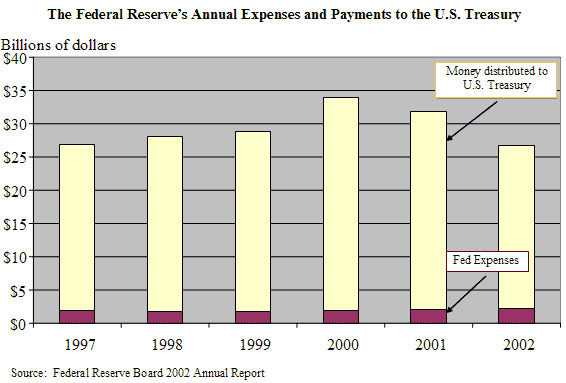Yes and no. The Federal Reserve (the Fed) enjoys a unique public/private structure that operates within the government, but is still relatively independent of government to isolate the Fed from day-to-day political pressures in fulfilling its varying roles. As stated in The Federal Reserve System Purposes & Functions:
The Federal Reserve System is considered to be an independent central bank. It is so, however, only in the sense that its decisions do not have to be ratified by the President or anyone else in the executive branch of the government. The entire System is subject to oversight by the U.S. Congress….the Federal Reserve must work within the framework of the overall objectives of economic and financial policy established by the government.
History
Prior to the Fed’s formation, the United States experienced a number of economic downturns and financial panics. To help alleviate the problems associated with these swings in the economy, President Woodrow Wilson signed the Federal Reserve Act on December 23, 1913. The act’s opening paragraph outlines its varying functions:
An Act to provide for the establishment of Federal reserve banks, to furnish an elastic currency, to afford means of rediscounting commercial paper, to establish a more effective supervision of banking in the United States, and for other purposes.
Since 1913, legislation has passed to augment some of the act’s original purposes and to clarify the varying roles of the Fed.
Structure
Congress set up the Federal Reserve System to make it autonomous and to isolate it from day-to-day political pressures. For example, the members of the Board of Governors are appointed to serve 14-year terms that do not coincide with presidential terms. Key components of the Federal Reserve System are:
- The Board of Governors—Located in Washington, D.C., Board members are appointed by the U.S. President and confirmed by the U.S. Senate. Board members and staff are civil service employees.
- The 12 regional Reserve Banks—Located around the country, the 12 Federal Reserve Banks are chartered as private corporations. Employees are not civil service.
- The Federal Open Market Committee (FOMC)—Composed of the Federal Reserve Governors and the Federal Reserve Bank presidents, the FOMC is charged with conducting monetary policy.
The 12 Federal Reserve Banks operate like other businesses; each has its own board of directors that selects the Reserve Bank president and first vice president, with approval from the Board of Governors. Each Branch of a Reserve Bank has its own board of directors. A majority of these directors are appointed by the Branch’s Reserve Bank; the others are appointed by the Board of Governors.
Boards of directors of the Reserve Banks and their Branches provide the Federal Reserve System with a wealth of information on economic conditions in every corner of the nation. The information, along with other sources, is used by the FOMC and the Board of Governors when reaching decisions about monetary policy.
Key Responsibilities
While Congress establishes key objectives the Fed must follow, the Fed generally works independently of the federal government to administer its core responsibilities.
Those duties include:
- Conducting monetary policy
- Supervising and regulating banking and financial institutions
- Providing payments services to financial institutions
The 12 Federal Reserve Banks have “independent” research staffs that advise their Reserve Bank presidents on monetary policy and the economy. Each Reserve Bank also has regulatory responsibilities including the supervision and regulation of financial institutions. The Reserve Banks also handle the Federal Reserve System’s business operations—it is in this area that Reserve Banks operate more like private businesses, selling services like electronic funds transfers, check processing, and coin and currency services to financial institutions.
Funding
Congress also created the Federal Reserve System to be self-funding. The Fed earns interest on the interest-bearing government securities it holds in its portfolio and sells financial services to banks. This amount is reported each year in its annual report. The Fed’s earnings typically far exceed its expenses. However, unlike for profit corporations, the Fed distributes any profit (after costs) to the U.S. Treasury. In 2002, the Fed’s operating revenues were $26.7 billion, expenses total $2.2 billion, and $24.5 billion was paid to the treasury as “interest on Federal Reserve Notes.” The graph below displays the flow of the Fed’s annual payments to the U.S. Treasury for the past five years.
<p align="center"
References
Dunne, Gerald T. A Christmas Present for the President: A Short History of the Creation of the Federal Reserve System. Federal Reserve Bank of St. Louis. 1984.
Board of Governors of the Federal Reserve System 2002 Annual Report, pp.286-87.
The Federal Reserve System in Brief, Federal Reserve Bank of San Francisco, August 2000
The Federal Reserve System Purposes and Functions. Board of Governors of the Federal Reserve System. 1994.
Making Sense of Money: Personal Financial Education, Federal Reserve Bank of San Francisco 2002 Annual Report, pp. 43-57.
Stevens, Edward. 1996. “The Founders Intentions: Sources of the Payment Services Franchise of the Federal Reserve Banks.” Financial Services Working Paper.